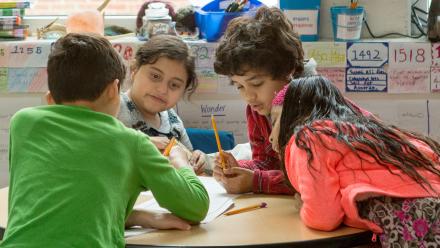Key Information
Focus
When To Use This Strategy
Appropriate Group Size
Why use reciprocal teaching?
- It encourages students to think about their own thought process during reading.
- It helps students learn to be actively involved and monitor their comprehension as they read.
- It teaches students to ask questions during reading and helps make the text more comprehensible.
How to use reciprocal teaching
Before Reciprocal Teaching can be used successfully by your students, they need to have been taught and had time to practice the four strategies that are used in reciprocal teaching (summarizing, questioning, predicting, clarifying).
One way to get students prepared to use reciprocal teaching: (from Donna Dyer of the North West Regional Education Service Agency in North Carolina)
- Put students in groups of four.
- Distribute one note card to each member of the group identifying each person’s unique role:
- Summarizer
- Questioner
- Clarifier
- Predictor
- Have students read a few paragraphs of the assigned text selection. Encourage them to use note-taking strategies such as selective underlining or sticky-notes to help them better prepare for their role in the discussion.
- At the given stopping point, the Summarizer will highlight the key ideas up to this point in the reading.
- The Questioner will then pose questions about the selection:
- Unclear parts
- Puzzling information
- Connections to other concepts already learned
- The Clarifier will address confusing parts and attempt to answer the questions that were just posed.
- The Predictor can offer predictions about what the author will tell the group next or, if it’s a literary selection, the predictor might suggest what the next events in the story will be.
- The roles in the group then switch one person to the right, and the next selection is read. Students repeat the process using their new roles. This continues until the entire selection is read. (Source: ReadingQuest )
- Throughout the process, the teacher’s role is to guide and nurture the students’ ability to use the four strategies successfully within the small group. The teacher’s role is lessened as students develop skill.
For more information, see the article Reciprocal Teaching for the Primary Grades: “We Can Do It, Too!”.
Download blank templates
- Here’s a bookmark for students to use that prompts them about each of the four strategies used in reciprocal teaching.
- This worksheet incorporates all four strategies into one page that students can fill out.
- Similar to the bookmark above, this four-column handout prompts students with questions and statements related to the four strategies.
Watch reciprocal teaching in action
At Frank Love Elementary School, reading expert Shira Lubliner uses reciprocal teaching to guide students in learning to lead a classroom discussion. But first, Ms. Lubliner shows them how to guide a conversation about a book.
Collect resources
Language Arts
The following website shows an example of the Reciprocal Teaching strategy for the book The Man Who Walked Between the Towers. See example ›
Differentiated instruction
For second language learners, students of varying reading skill, and younger learners
- Pair a student with lower reading skills with one who is more advanced to work together.
- Ask student to write out questions about parts of the story that doesn’t make sense to them.
See the research that supports this strategy
Oczuks, L. (2003). Reciprocal teaching at work: Strategies for improving reading comprehension. Newark, DE: International Reading Association.
Palincsar, A. S. & Brown, A. (1984). Reciprocal Teaching of Comprehension-Fostering and Comprehension Monitoring Activities. Cognition and Instruction, 1(2), pp. 117-175.
